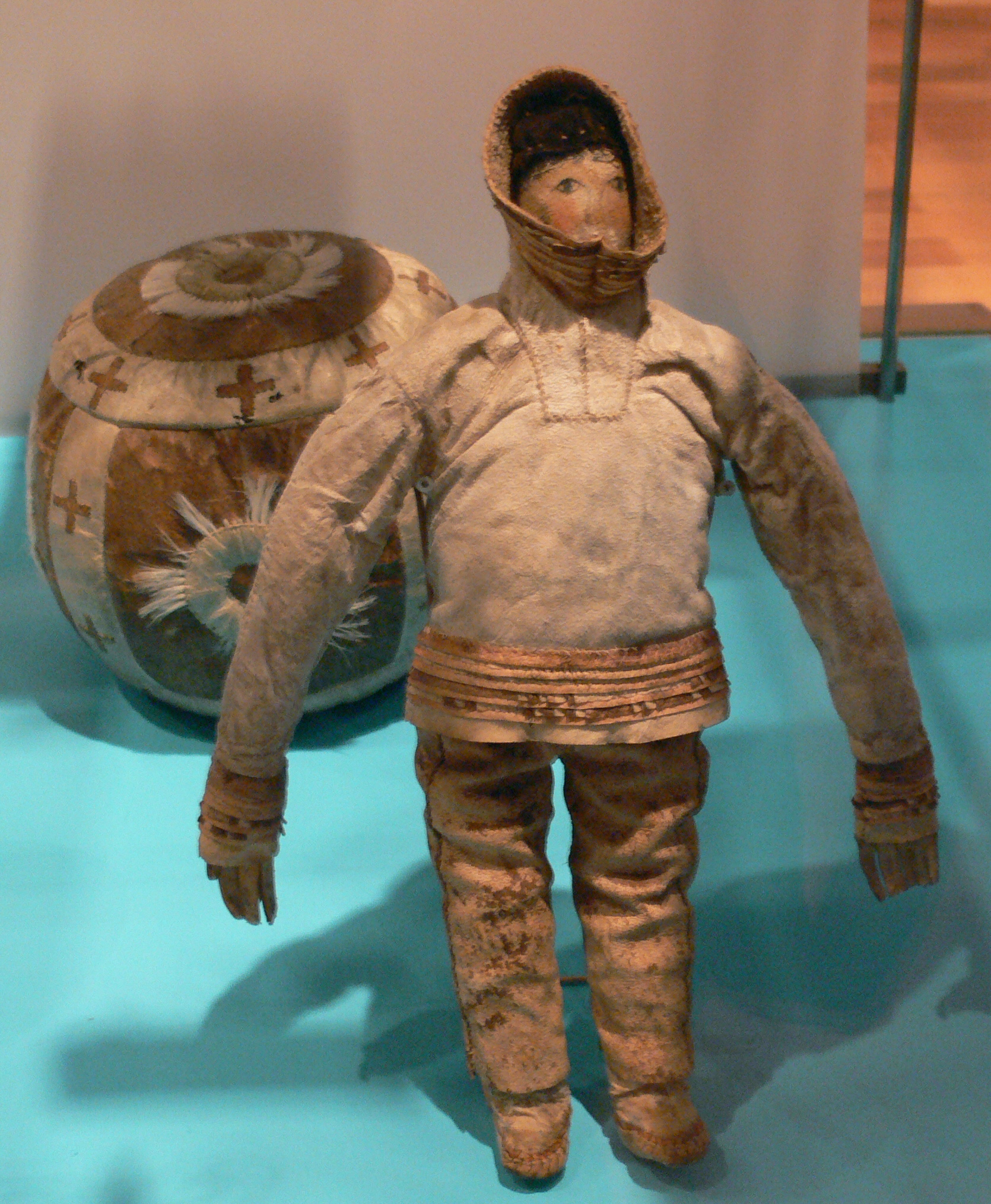Inuit doll on:
[Wikipedia]
[Google]
[Amazon]


Inuit
Inuit (; iu, ᐃᓄᐃᑦ 'the people', singular: Inuk, , dual: Inuuk, ) are a group of culturally similar indigenous peoples inhabiting the Arctic and subarctic regions of Greenland, Labrador, Quebec, Nunavut, the Northwest Territories ...
dolls are made out of soapstone
Soapstone (also known as steatite or soaprock) is a talc-schist, which is a type of metamorphic rock. It is composed largely of the magnesium rich mineral talc. It is produced by dynamothermal metamorphism and metasomatism, which occur in the ...
and bone
A bone is a rigid organ that constitutes part of the skeleton in most vertebrate animals. Bones protect the various other organs of the body, produce red and white blood cells, store minerals, provide structure and support for the body, ...
, materials common to the people of northern Alaska
Alaska ( ; russian: Аляска, Alyaska; ale, Alax̂sxax̂; ; ems, Alas'kaaq; Yup'ik: ''Alaskaq''; tli, Anáaski) is a state located in the Western United States on the northwest extremity of North America. A semi-exclave of the U.S. ...
, Greenland
Greenland ( kl, Kalaallit Nunaat, ; da, Grønland, ) is an island country in North America that is part of the Kingdom of Denmark. It is located between the Arctic and Atlantic oceans, east of the Canadian Arctic Archipelago. Greenland i ...
and northern Canada. Many are clothed with animal fur
Fur is a thick growth of hair that covers the skin of mammals. It consists of a combination of oily guard hair on top and thick underfur beneath. The guard hair keeps moisture from reaching the skin; the underfur acts as an insulating blanket t ...
or skin. Their clothing articulates the traditional style of dress necessary to survive cold winters, wind, and snow. Dolls could have been gifts to young Inuit girls, to be used as teaching devices and passing down of culture. With these dolls, young girls learn various skills necessary for their survival such as skin preparation, cutting & sewing, proper use of materials, designs and significance of symbols in their cultures. Inuit dolls were enjoyed by both young and old Inuit individuals and give an excellent insight into Inuit culture.
History
The earliest found dolls were made by Inuit living inBrooman Point Village
Based on archeological finds, Brooman Point Village is an abandoned village in Qikiqtaaluk Region, Nunavut, Canada. It is located in the central High Arctic near Brooman Point () of the Gregory Peninsula, part of the eastern coast of Bathurst Isl ...
, Bathurst Island over two thousand years ago. Since the migration of humans over the land bridge
In biogeography, a land bridge is an isthmus or wider land connection between otherwise separate areas, over which animals and plants are able to cross and colonize new lands. A land bridge can be created by marine regression, in which sea leve ...
in the Bering Strait, these dolls were common in Inuit culture. While the history of creating these dolls are unknown, the tradition may have started over 1,000 years ago. There are at least two different types of Inuit dolls from the Canadian region, Play dolls and Collector's Dolls.
Play dolls
Traditionally by the age of ten, Inuit girls were taught by their mothers how the clothe a family. This is mainly taught by learning to sew making their own dolls with removable clothing. They learn about the roles of wives and mothers by playing with these dolls. Once Inuit moved to camps and settlements, young girls started going to school and started learning different kinds of lessons and schools. This change in education for young Inuit girls, the play dolls began disappearing. The last generation to grow up with the play dolls were girls from the early 1950s.Collector's dolls
These dolls were typically made by Inuit for people in the south. Some are owned by museums and others are owned by private collectors and institutions. The collector's dolls were divided into four categories: dolls dressed in traditional fur garments, wearing fabric garments, made by elders from Spence Bay (Taloyoak), and lastly made by the best dollmakers in the same community. The dolls made by elders are full of energy and imagination. They are sculptures made from fur and fabric. Some are reminders of what the culture used to be like and others are just fantasy of the imagination the dollmaker. The dolls made by Spence Bay's best dollmakers are full of intense artistry. Dolls could have been made from caribou antler to create a certain texture. Dollmakers could have also usedsoapstone
Soapstone (also known as steatite or soaprock) is a talc-schist, which is a type of metamorphic rock. It is composed largely of the magnesium rich mineral talc. It is produced by dynamothermal metamorphism and metasomatism, which occur in the ...
to create eyes and generate certain emotions and feelings. Dollmakers have also made dolls specifically called Packing Dolls that generally wear an amauti
The amauti (also ''amaut'' or ''amautik'', plural ''amautiit'') is the parka worn by Inuit women of the eastern area of Northern Canada. Up until about two years of age, the child nestles against the mother's back in the amaut, the built-in baby ...
. Packing dolls refer to dolls that have a parka
A parka or anorak is a type of coat with a hood, often lined with fur or faux fur. This kind of garment is a staple of Inuit clothing, traditionally made from caribou or seal skin, for hunting and kayaking in the frigid Arctic. Some Inuit ...
that is designed with a baby pouch tailored as part of the mother's clothing.
See also
* Yup'ik dollReferences
{{Reflist *Bachmann, Manfred & Hansmann, Claus. ''Dolls the World Over''. New York: Crown Publishers, 1973. *Jones, Suzi, Ed. ''Eskimo Dolls''. Alaska State Council of the Arts, 1982. *Larson, Jack Lenor. ''Folk Art from the Global Village''. Santa Fe, NM: Museum of New Mexico Press, 1995. Traditional dolls Inuit culture